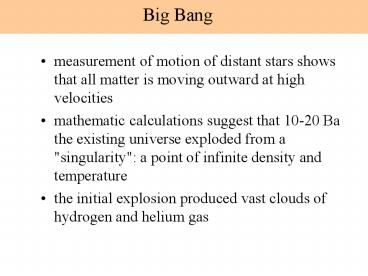Big Bang - PowerPoint PPT Presentation
1 / 25
Title:
Big Bang
Description:
... solid particles became cemented into planetesimals (1 km or so in ... as the moon) form when a planetesimal is attracted by the gravitational pull of ... – PowerPoint PPT presentation
Number of Views:56
Avg rating:3.0/5.0
Title: Big Bang
1
Big Bang
- measurement of motion of distant stars shows that
all matter is moving outward at high velocities - mathematic calculations suggest that 10-20 Ba the
existing universe exploded from a "singularity"
a point of infinite density and temperature - the initial explosion produced vast clouds of
hydrogen and helium gas
2
(No Transcript)
3
Formation of Galaxies
- within each cloud, gravitation pull caused the
gas to contract into swirling masses
(protostars), eventually becoming stars and
groups of stars (galaxies)? - The Milky Way galaxy formed around 15 Ba some of
the stars date back to this age - around 99 of the mass of the universe is
hydrogen and helium around 1 is heavier matter
formed during the evolution and break up of stars
4
(No Transcript)
5
Birth of Stars
- stars range in temperature, from M (red, low
temp.) to O (blue, high temp.). - our sun in classified as G (intermediate temp.,
yellow)? - stars are initially created through gas
contraction, which causes nuclear fusion
(hydrogen to helium)? - continuing fusion allows stars to release
enormous amounts of radiant energy
6
(No Transcript)
7
Aging of Stars
- stars remain in this state for billions of years
(middle size stars) or millions of years (massive
stars). - when hydrogen has been mostly converted to
helium, stars expand, becoming red giants (with
helium cores), or red supergiants (with carbon
cores)?
8
Hertzsprung-Russell Diagram
- The H-R diagram plots the relation between mass,
temperature, and luminosity for stars in the
active phase of nuclear fusion (90 the duration
of a star's existence) - Following this they become less hot, less
luminous, and less massive
9
(No Transcript)
10
Death of Stars
- middle size stars
- mantles of hot gas are thrown off, forming
ejection nebula - a white dwarf forms at the center
- massive stars
- fuse to an iron core, followed by a catastrophic
supernova explosion (2-3 times a century in our
galaxy)? - the remaining core of supernovae, can implode
into a black hole from which no matter or even
light can escape
11
(No Transcript)
12
(No Transcript)
13
Nebulae
- Emission Nebulae clouds of high temperature gas,
energized by ultraviolet light from a nearby star - Reflection Nebulae clouds of dust which reflect
the light of nearby stars - Dark Nebulae clouds of dust which block light
from whatever is behind. - Planetary (Ejection) Nebulae shells of gas
thrown out dying middle sized stars - Supernova Remnants explosion of a supergiant
star
14
Figure 2.1
15
Evolution of the Solar System
- our solar system formed around 4.6 Ba from a
swirling cloud of gas and dust (tiny grains of
ice, silicates, and metals)? - the sun formed in the center composed mainly of
hydrogen, releasing radiant energy as hydrogen
fuses to helium
16
Formation of Planets
- within the rings of gas surrounding the sun,
solid particles became cemented into
planetesimals (1 km or so in diameter),
eventually coalescing into planets - within planets, radioactive decay caused
convection (rising of hot, less dense materials),
giving rise to volcanic eruptions - over time, separation by weight occurred iron
sank to form a core, surrounded by less dense
silicate or hydrogen mantles and gaseous
atmospheres
17
Our Solar System
Figure 2.1
18
Inner and Outer Planets
- the 5 "outer planets" (Jupiter, Saturn, Uranus,
Neptune, Pluto) retain the initial
hydrogen/helium atmospheres - in the 4 "inner planets" (Mercury, Venus, Earth,
Mars) the initial atmosphere was lost, replaced
via emission of volcanic gases - Venus is surrounded by a dense atmosphere of
mainly CO2 Mars has a very thin atmosphere, also
mainly CO2, Mercury has almost no atmosphere
19
(No Transcript)
20
Asteroids and Comets
- between the inner and outer planets lies a belt
of asteroids, formed from a fifth ring of rocky
planetesimals that failed to coalesce - beyond the outer planets lie numerous comets,
consisting mainly of gaseous planetesimals - if captured by the gravitational pull of a
planet, a comet can be drawn closer to the sun - the gases begin to vaporize, leaving behing a
trail of dust
21
(No Transcript)
22
Satellites and Meteorites
- satellites (such as the moon) form when a
planetesimal is attracted by the gravitational
pull of a planet, but not so strongly as to cause
a collision - meteorites asteroids and comets arriving on a
planet or satellite, may produce large impact
craters - on planets with adequate atmospheres most
meteorites burn up in transit
23
(No Transcript)
24
(No Transcript)
25
(No Transcript)































